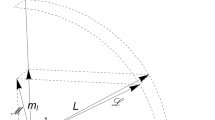Summary
In this paper the orbital momentumj, until now considered as an integer discrete parameter in the radial Schrödinger wave equations, is allowed to take complex values. The purpose of such an enlargement is not purely academic but opens new possibilities in discussing the connection between potentials and scattering amplitudes. In particular it is shown that under reasonable assumptions, fulfilled by most field theoretical potentials, the scattering amplitude at some fixed energy determines the potential uniquely, when it exists. Moreover for special classes of potentialsV(x), which are analytically continuable into a functionV(z),z=x+iy, regular and suitable bounded inx > 0, the scattering amplitude has the remarcable property of being continuable for arbitrary negative and large cosine of the scattering angle and therefore for arbitrary large real and positive transmitted momentum. The range of validity of the dispersion relations is therefore much enlarged.
Riassunto
Nel presente lavoro viene definita l’interpolazione degli sfasamenti nello scattering da potenziale per valori generalmente complessi del momento orbitale. Tale definizione si presta particolarmente a discutere le proprietà analitiche (tra cui la rappresentazione di Mandelstam) dell’ampiezza di scattering giovandosi all’uopo di un metodo dovuto a Watson sueccessivamente perfezionato da Sommerfeld.
Similar content being viewed by others
References
E. Wigner andJ. Neumann:Annals of Math.,59, 418 (1954).
D. S. Carter:Thesis, Princeton;N. Khuri:Phys. Rev. 107 1148 (1957). We have had no opportunity of examining directlyCarter’s work and we know of his result only throughKhuri’s paper.
I. M. Gel’fand andLevitan:Amer. Math. Soc. Trans., Sec. 2.1.250 (1955).
R. Jost andW. Kohn:Math. Phys. Medd.,27, (9) (1953).
L. D. Faddeev:Soviet Phys. Dokl. Transl.,3, 747 (1959).
E. C. Titchmarsh:Eigenfunction Expansions, associated with second order differential equations I, II. (Oxford, 1946).
A. Sommerfeld:Partielle Differential-Gleichungen der Physik (Leipzig, 1947), p. 285.
S. Gasiorowicz andH. P. Noyes:Nuovo Cimento,10, 78 (1958).
R. P. Boas:Entire Functions (New York, 1955).
Author information
Authors and Affiliations
Rights and permissions
About this article
Cite this article
Regge, T. Introduction to complex orbital momenta. Nuovo Cim 14, 951–976 (1959). https://doi.org/10.1007/BF02728177
Received:
Published:
Issue Date:
DOI: https://doi.org/10.1007/BF02728177



